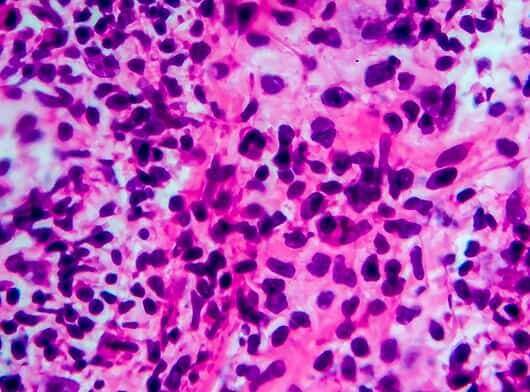- The lymphatic system is a part of our immune system. Clear fluid called lymph flows through the lymphatic vessels and contains infection-fighting white blood cells, known as lymphocytes.
- The main types of lymphocytes are T-cells and B-cells, which are white blood cells made in the bone marrow. B-cells remain in the bone marrow to mature, while T-cells mature in the thymus, a small organ nestled between the lungs.
- Lymphoma begins when healthy cells in the lymphatic system change and grow out of control. This uncontrolled growth may form a tumour, involve many parts of the lymphatic system, or spread to other parts of the body. B-cells are far more likely than T-cells to mutate and cause cancer such as Hodgkin lymphoma, non-Hodgkin lymphoma or leukaemia.
- The main difference between Hodgkin lymphoma and Non-Hodgkin lymphoma is the presence or absence of oversized B-cells called Reed-Sternberg cells. These cells are usually detected during a biopsy and indicate the presence of Hodgkin lymphoma.
Hodgkin lymphoma types
- Nodular sclerosis: This is the most common subtype of classical Hodgkin lymphoma. It often occurs in children and young adults, especially young women, and is most often found in the chest and/or neck. This subtype may cause fibrous scars in the lymph nodes.
- Mixed cellularity: This accounts for about 25 percent of all classical Hodgkin lymphoma cases and is more common among older adults. This subtype is often found in the abdomen.
- Lymphocyte-rich: This form of Hodgkin lymphoma accounts for 5 percent of all classical cases and is most often diagnosed in men.
- Lymphocyte-depleted: This extremely rare disease represents less than 1 percent of all Hodgkin lymphomas and is most often diagnosed in older adults or people with HIV.
- A less common type is nodular lymphocyte-predominant Hodgkin lymphoma (NLPHL), which affects about 5 percent of Hodgkin lymphoma patients. NLPHL is characterized by the presence of so-called popcorn cells, lobular versions of Reed-Sternberg cells that resemble popcorn. NLPHL is most often diagnosed in middle-aged adults


